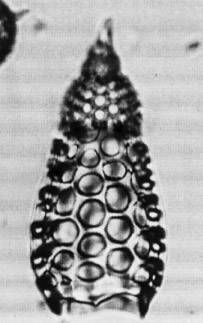 Podocyrtis
(Lampterium) chalara Riedel and Sanfilippo
Podocyrtis
(Lampterium) chalara Riedel and Sanfilippo Podocyrtis
(Lampterium) chalara Riedel and Sanfilippo
Podocyrtis
(Lampterium) chalara Riedel and SanfilippoPodocyrtis (Lampterium) chalara Riedel and Sanfilippo, 1970, p.535, pl.12, figs.2-3; Riedel and Sanfilippo, 1978a, p.71, pl.8, fig.3, text-fig.3
Cephalis [three-lobed], irregularly hemispherical, with few to many small pores, and bearing a stubby bladed horn. Thorax thick-walled with rough surface approximately hemispherical, with rather large subcircular pores. Collar and lumbar strictures distinct. Abdomen robust, with smooth surface, of very large subangular meshes usually in approximate longitudinal rows; in outer form it expands slightly, then contracts distally. Abdominal pores commonly have short thorns projecting inward from their periphery. Vestigial triangular teeth are rarely present (Riedel and Sanfilippo, 1970).
Thorax 40-65 µm long, 80-95 µm wide. Abdomen 155 (rarely 85) - 255 µm long and 125 (rarely 100) - 165 µm wide (Riedel and Sanfilippo, 1970).
This species is distinguished from P. (L.) mitra by having less than 13 pores around the widest part of the circumference of the abdomen (Riedel and Sanfilippo, 1978a, p.86), and from P. (L.) goetheana as indicated under that species. From P. (L.) trachodes, P. (L.) chalara is distinguished by larger pores and usually smooth outline (Sanfilippo et al., 1985).
The small thorax, with rough surface and pores not longitudinally aligned, shows little variation. The abdomen is shorter in early than in late forms, with the exception that in some of these latter it is reduced to two or three rows of large pores and is therefore abnormally short. The large, subangular pores of the abdomen increase in size with time, and towards the end of the range they lose their longitudinal alignment (Sanfilippo et al., 1985).
P. (L.) chalara occurs in tropical assemblages of late middle Eocene age. Its evolutionary transition from Podocyrtis mitra defines the base of the Podocyrtis chalara Zone. Its morphotypic last appearance is near the top of the Cryptocarpium azyx Zone.
P. (L.) chalara evolved directly from P. (L.) mitra, and gave rise to P. (L.) goetheana.
Additional illustrations can be found in Riedel and Sanfilippo, 1981, fig.12-7, nos.5-6, fig.12-8, nos.9-12.